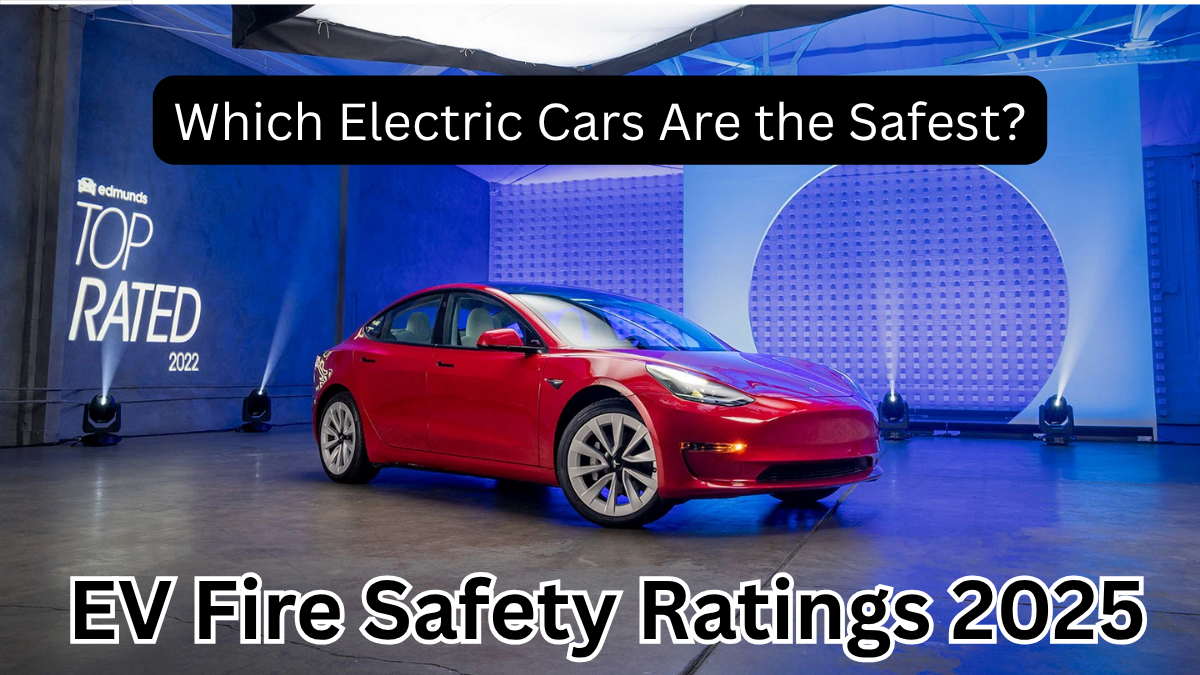Electric vehicles (EVs) are no longer futuristic—they’re the now. But with rising adoption comes a new wave of concerns, especially about battery safety and fire hazards. If you’re planning to buy an EV in 2025, one major question stands out: Which electric cars are actually the safest when it comes to fire risks?
Let’s break it down with the latest safety ratings, expert insights, and tips to protect your investment.

Table of Contents
Why EV Fire Safety Matters More Than Ever

While EVs are statistically less likely to catch fire than gas vehicles, when fires do occur, they’re trickier to control due to the high-energy lithium-ion batteries.
Here’s why EV Fire Safety Rating 2025 is critical:
-
Battery technology is evolving, but not all EVs have equal safety features
-
Fire incidents, though rare, tend to gain wide media attention
-
Insurance companies are adjusting premiums based on fire risk data
-
Consumers are demanding greater transparency and safety testing
Top Safest Electric Cars in 2025 Based on Fire Safety Ratings
We’ve compiled a list of EVs rated for superior battery safety and minimal fire risk, based on crash test data, thermal management systems, and battery insulation.
Top-Rated EVs for Fire Safety (2025)
| EV Model | Fire Safety Score | Battery Type | Thermal Management | Insurance Premium Trend |
|---|---|---|---|---|
| Tesla Model Y | 9.5/10 | Lithium-Ion | Active Liquid Cooling | Low to Moderate |
| Hyundai Ioniq 6 | 9.2/10 | Solid-State (Pilot) | Advanced Passive Cooling | Low |
| Ford Mustang Mach-E | 9.0/10 | Lithium-Ion | Liquid-Cooled Battery | Moderate |
| BMW i4 | 8.8/10 | Lithium-Ion | Thermal Cut-off Modules | Moderate |
| Kia EV6 | 8.6/10 | Lithium-Ion | High-Efficiency Cooling | Moderate |
| Nissan Ariya | 8.3/10 | Lithium-Ion | Integrated Heat Shielding | Slightly High |
Note: Scores are based on international fire safety testing benchmarks and manufacturer disclosures for EV Fire Safety Rating 2025.
Key Technologies That Reduce Fire Risk in EVs
Modern electric cars are equipped with advanced features to prevent thermal runaway and battery combustion. Look out for these when choosing an EV:
-
Battery Management Systems (BMS): Monitors and controls battery temperature and voltage
-
Thermal Barriers: Separate battery cells to prevent fire spread
-
Auto Shut-Off Circuits: Automatically disconnect the battery in the event of a crash
-
Crash Sensors & Cooling Systems: Help regulate battery heat even in high-impact accidents
How EV Fire Ratings Affect Your Insurance
Yes, insurance providers are now factoring in battery safety and fire risk when calculating premiums. A vehicle with a higher EV Fire Safety Rating 2025 typically qualifies for:
-
Lower insurance premiums
-
Faster claim approvals
-
Access to EV-specific policies
Insurance companies also value:
-
Manufacturer fire safety certifications
-
Proven accident data from NHTSA and Euro NCAP
-
In-vehicle fire suppression systems
Tips to Choose a Safe Electric Car
When shortlisting your EV, consider these safety-first pointers:
-
Check fire safety ratings from trusted agencies (NHTSA, Euro NCAP, IIHS)
-
Inspect warranty terms on battery and fire-related damage
-
Ask about thermal management technology used in the EV
-
Read reviews from real owners and crash-test results
-
Compare insurance quotes before purchase
FAQs
What is the EV Fire Safety Rating 2025?
EV Fire Safety Rating 2025 is a standardized score given to electric vehicles based on their fire resistance, battery containment technology, and thermal control systems. It helps buyers choose safer EVs.
Are EVs more prone to catching fire than petrol cars?
No. Studies show EVs are statistically less likely to catch fire than gasoline vehicles. However, EV fires tend to burn hotter and longer due to lithium-ion batteries, making battery safety crucial.
How do fire ratings affect EV insurance premiums?
Insurance companies consider the fire safety rating, crash data, and battery design to assess risk. EVs with high fire safety scores often get better insurance rates.
Which EV has the best battery safety in 2025?
As of 2025, Tesla Model Y and Hyundai Ioniq 6 lead the pack in battery safety, thanks to their advanced thermal management and real-world performance in crash simulations.
Final Thoughts
The EV revolution is here to stay—but safety should always ride shotgun. With the EV Fire Safety Rating 2025 as your guide, you can make an informed and confident choice. Whether you’re a first-time buyer or upgrading your ride, prioritize battery safety, review insurance options, and drive into the future fully protected.
Click here to learn more







